7 July - Some history, some engineering and the odd glass of wine

|
37:50.52N 76:16.42W 
Escapade dressed overall for 4th July Independence Day at Reedville
Whilst we were in Reedville and had the hire car, we took the opportunity to see a bit more of the local area.
With Independence Day so close, a trip to Yorktown to see where the British were defeated seemed like an obvious thing to do. It sits on the banks of the York River, not far from Jamestown and Williamsburg.
The Americans have done a wonderful job of connecting these three sites together and preserving their history.
They apologise much too easily for having a relatively short history: what they have has had a profound effect on the rest of the world and they work hard preserving and presenting it for Everyman to see. 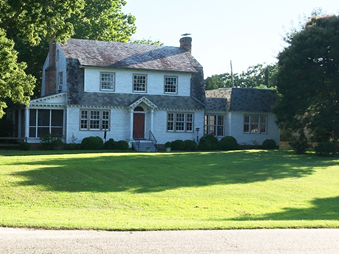
Yorktown – beautiful, peaceful and remarkably ‘English’
You can do the Yorktown Battlefield Tour by car – this is America, after all.
And actually it was close to 100oF that afternoon and we didn’t have very much time.
The town itself is very pretty, very quiet and reminiscent of a quintessential English village on a bigger scale.
The story of the British defeat does not make great reading: Lord Cornwallis had brought his army up from the Carolinas hoping to drum up local support, but not much was forthcoming.
Watching current events at home, I sense that once people get the idea of ‘independence’ into their heads, it can be quite difficult to turn them back?
The French had a good alliance with Washington’s government and army, whilst perhaps London’s focus was more on Europe than the pesky Colonies?
Anyway, the French Navy kept the Royal Navy at bay and Cornwallis’ beleaguered army was not relieved or reinforced.
For better or worse, he decided to dig in at Yorktown.
Once the Franco-American forces commenced a siege, it seems to me that the heavily outnumbered British could see the writing on the wall.
Today, you can climb on the French siege lines as they moved inexorably forward towards the British, digging new earthworks each night without being detected and finally opening up their artillery at almost point blank range.
Why didn’t the British send out patrols and find or disrupt them?
Where was the counter attack? Was this simply a case of trying to survive to fight another day? I have not read enough to know the answers – except that history shows that Cornwallis surrendered and this is where
the United States really began as an independent nation.
No wonder my French counterparts used to tease me that France is actually America’s oldest Ally… they are right!
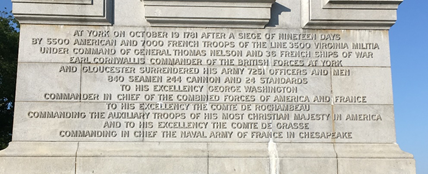
Inscription on the National Monument at Yorktown, VA
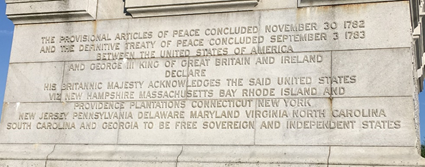
Another…

And another, perhaps the most relevant to the British…
Brian Dyke is a marine engineer working for the Cockrell business on the Little Wicomico River.
His provenance for our job was that he had rebuilt the Perkins diesel head gasket on one of the classic Skipjack Oyster fishing boats at Reedville Museum – or more precisely the ‘push boat’.
The law stated that oyster boats could not be propelled by machinery, so the lawyers found the owners a neat solution: a ten foot dinghy with a huge engine in it which could be ‘towed’ behind and when the circumstances demanded, provide some help to
propel the mother boat along. You see their descendants pushing huge barges all around these waters…
So when he turned up on Thursday morning after the Independence Day holiday we reran the contaminant test on the coolant and it came up as clean as a whistle.
We ran the engine for an hour at normal cruising revs whilst tied to Dave’s dock – watching carefully in case we started to carry it away!
No leaks from the new filler cap, no leaks from the repaired raw water exhaust.
No signs then, of a blown head gasket and no loss of coolant from the header tank.
Just to be sure, Brian took the old filler cap away to his workshop to conduct a pressure test on it.
It failed. All that fuss and the filler cap (which has had a tiny drip for months) turned out to be the culprit.
Still, we now have all the spares onboard to conduct a gasket change should we need one – and a second, spare filler cap!
We turned our attention to preparing for sea and the trip up through the Chesapeake towards the Chesapeake and Delaware Canal, a 12 mile shortcut that brings you out into the Delaware River south of Philadelphia.
I took down our dressing lines and battle ensigns that we had hoisted for the 4th July celebrations and got accosted by an elderly gentleman in a nearby house:
‘Captain, put your flags up.’
‘I’m sorry, could you say that again?’
‘Yes. Captain, put your flags back up’.
‘Er, no, actually. I’m going to sea and they get in the way.’
’Huh’.
That evening we went for a Thai supper in Kilmarnock with Neil, Ley, Walter and Mary.
The food at the Chao Praya was some of the best I’ve had outside Thailand – an unexpected delight in a rural corner of Virginia! 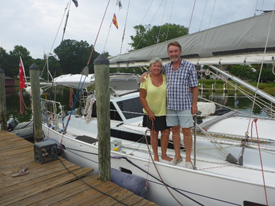
Neil and Ley Langford aboard Crystal Blues

Walter and Mary
I returned the hire car on Friday – an evolution that took most of the day in the end – and in the evening we had a fine crabcake dinner with Dave and Carol.
It’s a small world: Carol speaks Spanish, knows Barcelona well and worked in New York City in a similar field to Julie.
Dave is an experienced offshore yacht racer.
We all shared a similar view of the world and had a hoot!
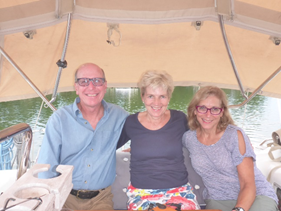
Julie with Dave Godwin and his wife Carol
aboard Escapade
So we sailed from Reedville on Saturday morning having made some lovely new friends, seen some beautiful parts of Virginia and Maryland, learnt a bit of history and quite a lot more about our splendid little Perkins M90 diesel!
The weather had changed too: after days of torrid heat and no wind, we actually had a north easterly breeze blowing.
Never mind that our destination (Oxford, on the Eastern Shore) was dead upwind – we changed it and decided to head for Solomons Island, on the north shore of the Patuxent River, instead. 
The pier at Reedville, reminiscent of the ‘screwpile’ lighthouses of the Chesapeake |